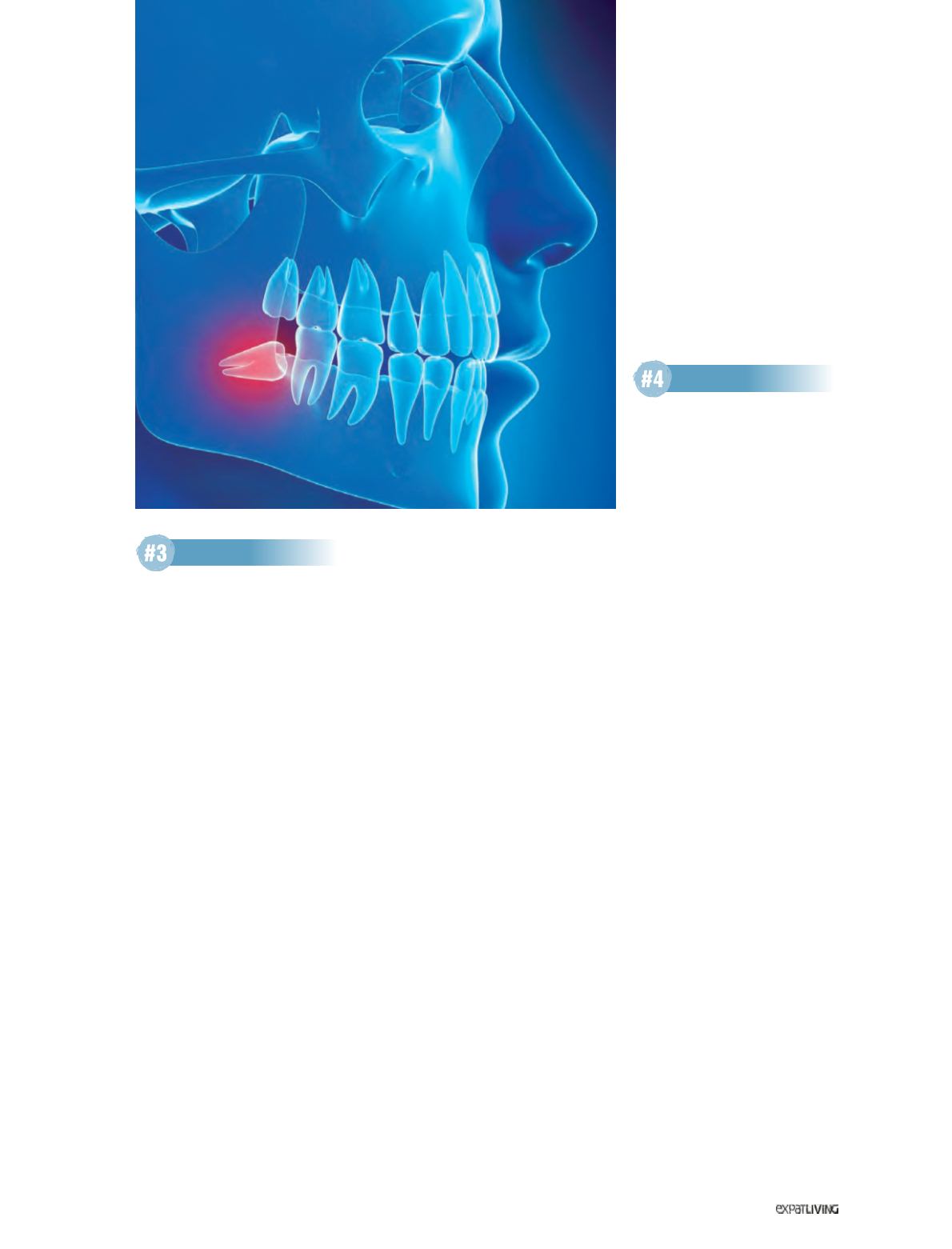

ORAL CARE
301
July14
Wisen Up!
Wisdom teeth removal doesn’t have to
be a painful and unpleasant experience,
says DR HO KOK SEN, dental specialist
in oral and maxillofacial surgery. “Most
patients are able to resume their normal
activities soon after they have done the
procedure. In fact, some patients attend
business dinners that same night!”
What are wisdom teeth?
Also known as third molars, wisdom
teeth emerge during early adulthood. A
panoramic dental radiograph (x-ray) will
confirm the number of wisdom teeth in
a person’s mouth and indicate whether
there are any buried teeth. In certain
cases, detailed 3D scans (known as
cone beam computed tomography) may
be done to pinpoint their exact position
in relation to important structures like the
dental nerve and maxillary sinus.
When are they a problem?
Wisdom teeth often do not properly erupt
and can grow sideways, emerge partway
out of the gum, or remain trapped
beneath the gum and bone, causing
chronic pain, migraines, headaches and
facial pain. When wisdom teeth do not
grow properly, the adjacent teeth are
more likely to decay; a tooth can become
so badly decayed that root canal therapy
may be the only way to salvage it, or
Tooth whitening
is a popular dental
technique to rejuvenate the colour of
teeth that have become dull and yellow
after years of accumulating internal
stains, says DR THEAN TSIN PIAO.
Did you know?
Unlike simple
scaling and polishing
,
which is a purely
mechanical process
that removes surface stains caused by
substances such as coffee, tea and red
wine,
tooth whitening
removes internal
stains through an
oxidation process
.
The most common ingredient used for
whitening teeth is
peroxide gel
.
Home or away?
•
The
take-home
whitening system
usually involves a customised tray filled
with peroxide gel in a 10- to 20-percent
concentration. You wear this tray for 30
minutes every day, for 14 days.
•
The
in-office
system is a one-off
treatment that uses a much higher
concentration of peroxide gel – 30
to 40 percent – and takes from
30 to 60 minutes. The higher the
concentration of gel, the faster the
whitening process.
What can you expect?
You can look forward to teeth that are
six to eight shades whiter – usually to
the colour of your teenage teeth. Teeth
may be sensitive during the whitening
procedure, but the effect is transient.
When using the take-home system, take
great care to ensure that the gel does not
come into contact with the gums, says
Dr Thean, or it will burn them.
Aesthete Smilestudio
6438 3811 | aesthetesmilestudio.com
Sebastian Kaulitzki | Dreamstime.com
it may even have to be replaced by a
dental implant.
Even when the wisdom teeth erupt
properly, there is a chance that there will
be a tight fit at the back of the mouth,
making it a challenge to clean the teeth
properly, which may lead to tooth decay.
When should they be removed?
Generally, it is recommended that
wisdom teeth be removed in one’s teens
or young adulthood, when recovery is
faster because the bone is more elastic
and the roots shorter. After the age of
30, you may be at greater risk for gum
disease in the surrounding tissues.
How is it done?
Surgical options include:
•
Local anaesthesia
, which is how
most minor oral surgery is performed.
•
Sedation
, where the oral surgery
is performed while the patient is in
a light sleep. This can be done in
the clinic with the assistance of an
anaesthetist.
•
General anaesthesia
, usually
administered in a hospital or day
surgery centre, which increase the
cost of treatment. Recovery from
anaesthesia is a little slower than with
sedation.
“Whichever you select,” says Dr Ho,
“rest assured that you will receive the
Lighten Up!
utmost care and attention to ensure your
safety and comfort both during and after
the procedure.”
Dr Ho Kok Sen
Specialist Dental Group
6733 7883 | specialistdentalgroup.com



















